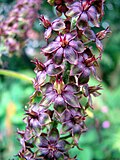Veratrum
-
Veratrum lobelianum illustration
-
Veratrum nigrum flowers
-
Veratrum album subsp. oxysepalum
-
Veratrum viride shoots
-
Veratrum stamineum
-
False hellebore from Alaska
Veratrum[edit]
Veratrum is a genus of highly toxic perennial herbs belonging to the family Melanthiaceae. These plants are commonly known as false hellebores and are native to temperate regions of the Northern Hemisphere, including North America, Europe, and Asia. Veratrum species are known for their striking appearance and potent alkaloids, which have been used historically in medicine and as poisons.
Description[edit]
Veratrum plants are characterized by their robust, erect stems, which can reach heights of 1 to 2 meters. The leaves are large, broad, and pleated, arranged in a spiral pattern around the stem. The flowers are small, star-shaped, and typically greenish-white or yellow, forming dense, terminal panicles.
The rootstock of Veratrum species is thick and rhizomatous, allowing the plant to survive in a variety of soil conditions. The entire plant contains toxic alkaloids, with the highest concentration found in the roots and rhizomes.
Toxicity[edit]
All parts of Veratrum plants are highly toxic due to the presence of steroidal alkaloids such as veratridine and cevadine. Ingestion of even small amounts can cause severe symptoms, including nausea, vomiting, abdominal pain, hypotension, bradycardia, and respiratory distress. In severe cases, poisoning can lead to death.
Historically, Veratrum alkaloids have been used in traditional medicine to treat conditions such as hypertension and as emetics. However, due to their narrow therapeutic index and high toxicity, their use is now largely obsolete.
Species[edit]
There are several species within the Veratrum genus, including:
- Veratrum album - Commonly known as white hellebore, native to Europe and parts of Asia.
- Veratrum viride - Known as American false hellebore, found in North America.
- Veratrum nigrum - Black false hellebore, native to Europe and Asia.
Each species has distinct geographical distributions and morphological characteristics, but all share the common trait of toxicity.
Habitat and Distribution[edit]
Veratrum species are typically found in moist, open habitats such as meadows, marshes, and along stream banks. They prefer rich, well-drained soils and are often found in mountainous regions.
In North America, Veratrum viride is commonly found in the eastern United States and Canada, while Veratrum album is widespread across Europe and parts of Asia.
Uses[edit]
Despite their toxicity, Veratrum species have been used in traditional medicine for centuries. Extracts from the plant were historically used as insecticides and to treat external parasites. In some cultures, Veratrum was used in rituals and as a poison for hunting.
Modern medical use of Veratrum alkaloids is limited due to their high toxicity and the availability of safer alternatives.
Related pages[edit]
Ad. Transform your life with W8MD's Budget GLP-1 injections from $75


W8MD offers a medical weight loss program to lose weight in Philadelphia. Our physician-supervised medical weight loss provides:
- Weight loss injections in NYC (generic and brand names):
- Zepbound / Mounjaro, Wegovy / Ozempic, Saxenda
- Most insurances accepted or discounted self-pay rates. We will obtain insurance prior authorizations if needed.
- Generic GLP1 weight loss injections from $75 for the starting dose.
- Also offer prescription weight loss medications including Phentermine, Qsymia, Diethylpropion, Contrave etc.
NYC weight loss doctor appointmentsNYC weight loss doctor appointments
Start your NYC weight loss journey today at our NYC medical weight loss and Philadelphia medical weight loss clinics.
- Call 718-946-5500 to lose weight in NYC or for medical weight loss in Philadelphia 215-676-2334.
- Tags:NYC medical weight loss, Philadelphia lose weight Zepbound NYC, Budget GLP1 weight loss injections, Wegovy Philadelphia, Wegovy NYC, Philadelphia medical weight loss, Brookly weight loss and Wegovy NYC
|
WikiMD's Wellness Encyclopedia |
| Let Food Be Thy Medicine Medicine Thy Food - Hippocrates |
Medical Disclaimer: WikiMD is not a substitute for professional medical advice. The information on WikiMD is provided as an information resource only, may be incorrect, outdated or misleading, and is not to be used or relied on for any diagnostic or treatment purposes. Please consult your health care provider before making any healthcare decisions or for guidance about a specific medical condition. WikiMD expressly disclaims responsibility, and shall have no liability, for any damages, loss, injury, or liability whatsoever suffered as a result of your reliance on the information contained in this site. By visiting this site you agree to the foregoing terms and conditions, which may from time to time be changed or supplemented by WikiMD. If you do not agree to the foregoing terms and conditions, you should not enter or use this site. See full disclaimer.
Credits:Most images are courtesy of Wikimedia commons, and templates, categories Wikipedia, licensed under CC BY SA or similar.
Translate this page: - East Asian
中文,
日本,
한국어,
South Asian
हिन्दी,
தமிழ்,
తెలుగు,
Urdu,
ಕನ್ನಡ,
Southeast Asian
Indonesian,
Vietnamese,
Thai,
မြန်မာဘာသာ,
বাংলা
European
español,
Deutsch,
français,
Greek,
português do Brasil,
polski,
română,
русский,
Nederlands,
norsk,
svenska,
suomi,
Italian
Middle Eastern & African
عربى,
Turkish,
Persian,
Hebrew,
Afrikaans,
isiZulu,
Kiswahili,
Other
Bulgarian,
Hungarian,
Czech,
Swedish,
മലയാളം,
मराठी,
ਪੰਜਾਬੀ,
ગુજરાતી,
Portuguese,
Ukrainian





